Operations off the Coast of the Netherlands
Germany invaded the
Netherlands on 10 May 1940 and five days later, one day after Rotterdam
was bombed on 14 May, Dutch forces surrendered.
It took six weeks for German troops to overrun Belgium, the
Netherlands, Luxembourg and France and sign an Armistice Agreement with
France on 22 June and during that time 300,000 troops of the British
Expeditonery Force (BEF) sent to France during the "phoney war" escaped
to Britain from Dunkirk.
The Netherlands remained neutral
during World War 1 and the Kaiser was exiled by the allies to the
Netherlands and died there in June 1941. The Dutch hoped to remain neutral in any future war with Germany and after
Hitler came to power in 1933 thousands of German Jews sought refuge in
the Netherlands, but Britain prepared contingency plans for a German
invasion of the Netherlands. The Admiralty's Plans Division at
HMS President, a shore base
in London, made plans for sending demolition teams of Kent Fortress
Engineers (KFRE), a Territorial Army (TA) unit at Gravesend on the
Thames estuary, to destroy oil refineries and oil reserves at
Amsterdam, Rotterdam and Antwerp, Operation XD. They would be led by
senior naval officers with a naval team of demolition experts to
destroy harbour installations in the ports of Ijmuiden (Amsterdam),
Hook of Holland (Rotterdam) and Flushing (Antwerp) and would be taken
there by Royal Navy destroyers.
Plans were made to bring to Britain Dutch gold reserves from the
Netherlands National Bank in Amsterdam and its branch in Rotterdam and
stocks of industrial diamonds belonging to members of the Amsterdam
Diamond Bourse. Once the invasion began plans changed as events
developed. Warships evacuated the Dutch Royal family, the Dutch
government, foreign legations and prominent industrialists in addition
to refugees, often Dutch or German Jews who had most to loose.
HMS Vivien was one of many V & W Class destroyers inluding HMS Malcom (V & W Class Leader), Wild Swan, Verity, Wolsey, Vesper, Windsor, Versatile, Witshed, Walpole, Vimiera, Winchester, Westminster, Wessex and Venomous at Nore Command (Harwich) and Dover which took part in these Operations in May 1940. Two V & W Class Destroyers, HMS Valentine and HMS Whitley were sunk and many more badly damaged including HMS Wivern. Operations off Dutch, Belgian and French coasts: reports, 1940 (NA ADM 199/795) at the National Archives contains the Reports of Proceeding of the Commanding Officers of these destroyers
and some of these will be added to this website after the
National Archives reopens. The National Archives also holds War Office
Report WO 106/1667 on Operation Harpoon to evacuate the Hook of Holland and the Admiralty report on the naval side of the operation, ADM 202/401.
**************
A month and a day after the invasion of Denmark and
Norway, Germany launched its blitzkrieg of the Low Countries and
France. By the 10 May the following destroyers had been
transferred to Nore Command (Harwich), including the Dover Sub Command
under Vice-Admiral Bertram H Ramsay: HMS
Vivien of Convoy C was detached from the Rosyth Command and HMS
Vimy, Versatile, Wessex, Walpole, Windsor, Vesper, Vivacious and
Venetia from various flotillas in Western Approaches Command.
- HMS Vivien's part in
Operations off the Coast of the Netherlands centered on the Hook of
Holland, in peacetime the ferry port which linked Parkstone Quay at
Harwich to the Netherlands. The Hook was on the New Waterway which
connected Rotterdam to the North Sea. If only Sub Lt Walkinshaw had
kept a journal we would have a much better understanding of events. As
it is all we have at present are the captions in his album and a basic
ouline of events derived from the chronolology in naval-history.net and
other sources.
- HMS Wild Swan had landed Cdr James Corrie Hill and XD-B (Rotterdam) at the Hook on 10 May and a detailed description of attempts to retrieve Dutch Gold and the destruction of refineries and oil reserves at Rotterdam is given on the website for Wild Swan. HMS Venomous and Verity landed 400 Marines to protect the perimeter of the Hook at sunrise on Sunday 12 May.
HMS
Wild Swan had damaged its propellor and HMS Malcolm (Captain T. E. Halsey, D.16) arrived at Hook of Holland at 0537/13th to relieve HMS
Wild Swan
as senior naval officer and take charge of the evacuation. At
0700 on Monday 13 May a mixed battalion of Welsh and Irish Guards led
by Lt Col Joseph Haydon was landed by SS
Canterbury and
Maid of Orleans (Operation
Harpoon) escorted by HMS
Keith, Wolsey, Wivern and
Borea.
The Hook was under constant attack by German bombers but plans to
evacuate the Royal Family, Dutch Governmment, foreign legations and
prominent industrialists could now be implemented. Queen Wilhelmina was
greeted by Lt Col Haydon, embarked in HMS
Herward and left for Britain at noon escorted by HMS
Vesper.
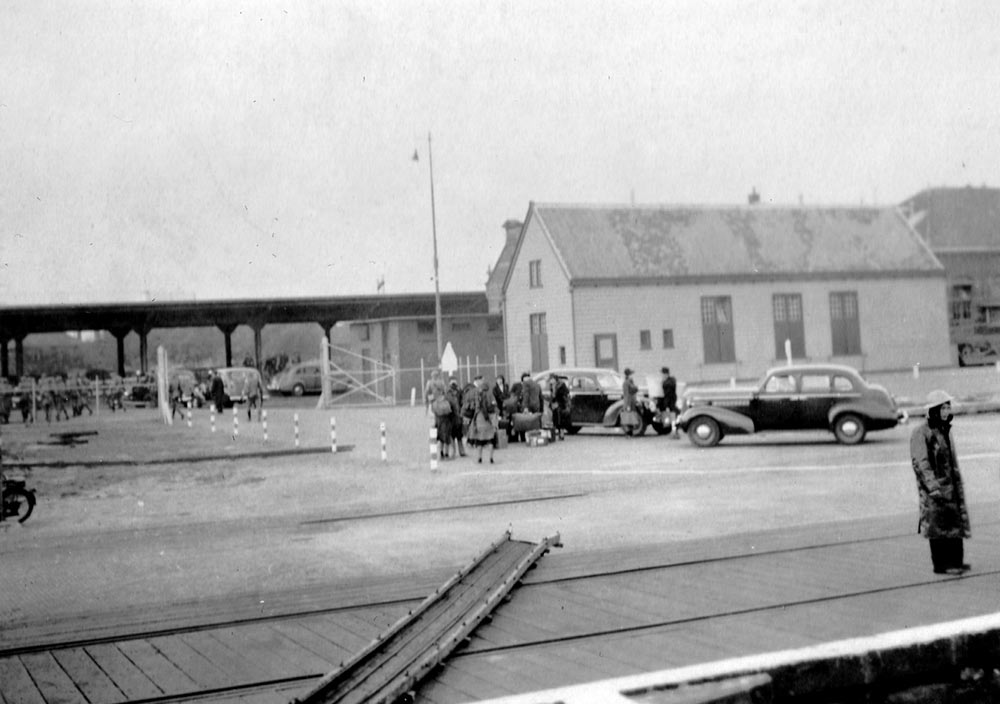 HMS Vivien berthed alongside at Hook of Holland and well dressed refugees are standing by their cars waiting to embark for Britain
Photographed by Sub Lt Herbert Walkinshaw RNVR and reproduced courtesy of Graham Cherry
HMS Vivien berthed alongside at Hook of Holland and well dressed refugees are standing by their cars waiting to embark for Britain
Photographed by Sub Lt Herbert Walkinshaw RNVR and reproduced courtesy of Graham Cherry
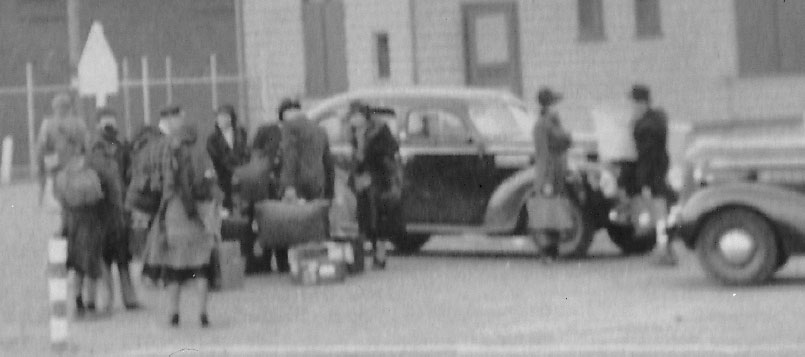
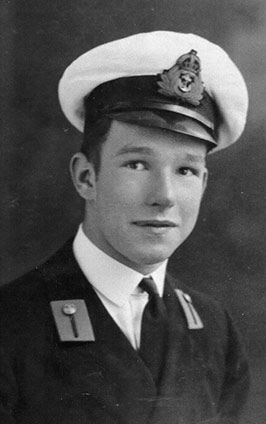
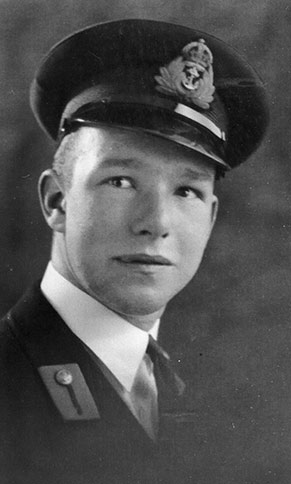
HMS
Vivien and HMS
Windsor
were two of the destroyers which carried out the evacuation from the
Hook of Holland on the evening of Whit Monday 13 May. We have an
eye witness account by M
idshipman Brian James Benson-Dare who was on
the bridge of HMS
Vivien during the evacuation.
Benson-Dare does not appear in any of the photographs in Herbert
Walkinshaw's album but his son, David Benson-Dare, sent me these two
taken on 12 September 1939 (left) and looking a little more mature on 8
July 1940 (right). White covers were added to caps in Summer until
Mountbatten decided it should be summer all year round and standardised
on white!
Mid. Benson-Dare related an amusing but revealing incident in a letter
to the Editor of the Newsletter of the V & W Destroyer Association
published in Issue 13, 2001:
"En route to England the French
Ambassador and his wife were among the evacuees. All females were
accommodated in the wardroom or officers’ cabins, including the
Captain’s. All men were accommodated for’d in the messdecks. This met
with the disapproval of the Ambassador who sent a message to the bridge
telling the Captain to come aft and see him as he required the
Captain’s cabin for himself and his wife. The crew were at action
stations. The captain could not leave the bridge and sent a message
that the Ambassador must come to the bridge, this he did and got no
sympathy. The Ambassador had to come for’ard, his wife and other
females occupied the Captain’s cabin.
Again, there was trouble as the Ambassador more or less demanded that
the ship should alter course to France as he did not wish to go to
England. France was being occupied by the Germans and there was heavy
bombardment by air and land. Again, this demand was refused. Midshipman
Benson-Dare was on the bridge at action stations when all this occurred.
In contrast, the Belgian Consul was most popular amongst the ship’s
company and when the evacuees were landed at Tilbury he was given a
rousing cheer and clapped as he went down the gangway."
The wardroom, Captain's cabin and the small cabins of the other officers were at the stern of
Vivien
beneath the raised quarter deck but above the waterline with access via
a small hatch and a steep ladder to a short corridor. The cramped
cabins with bunk beds were luxurious compared with the messdecks
beneath the raised foredeck where the ratings slept in hammocks. The
Captain had a small sea cabin immediately below the bridge where he
would be on call by the officer of the Watch at a moments notice. Lt
Cdr Weir must have been perplexed at having to consider questions of
protocol and ambassadorial dignity when at action stations and liable
to be bombed.
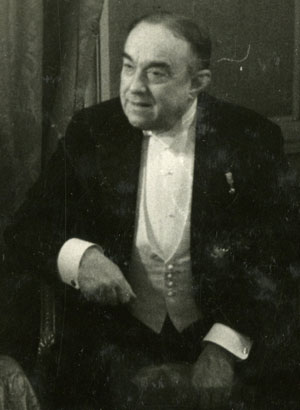
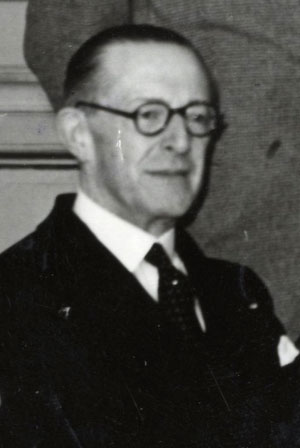
The Belgium Ambassador, Léon Charles Joseph Nemry,
was a 57 years old diplomat who began his career before the Great War
as Vice Consul at Cologne and served in Teheran, Manilla, Lima, Albania
and Copenhagen before being appointed head of the Embassy in The Hague
on 20 October 1939. The invasion of Belgium may have been anticipated
but not that of the Netherlands.
In London Léon Nemry became the Belgium Ambassador to the Dutch,
Norwegian and Greek Governments in exile and in 1945 returned to The
Hague as Ambassador until his retirement in 1949. He received
awards from their governments as well as his own. I would like to
acknowledge the assistance of the Belgium Diplomatic Archives which
supplied tthese details in response to an enquiry I made to the Belgium
Embassy in London. His photograph on the left, taken in 1948, is
in the Anefo Collection at the
Haags Gemeentearchief - click to view whole image.
The French Ambassador, Edouard Regis Bache,
was a 62 year old minor aristocrat with the title of Baron D'Arnauld de
Vitrolles. He had seven siblings and we hope to receive further details
of him from his family. The photograph on the right by Erich
Salomon was taken in 1935 (
Haags Gemeentearchief
Ref: 1.60183), click the image to view uncropped. The occupation of
France and the loss of his family and position in society must have
come as a shock. He died in a traffic accident during the wartime
"blackout" on 1 October 1940 and an obituary was published in the
Catholic Herald on 11 October 1940:
"Baron de Vitrolles was French Ambassador to Holland.
Solemn Requiem was celebrated at Notre Dame de France, Leicester Place,
on Monday, for the late French Ambassador to the Netherlands, Baron
d'Arnauld de Vitrolles; victim of an accident in the black-out last
week. He was run over by a vehicle in Hamilton Place, Piccadilly.
Baron de Vitlrolles came to London with Queen Wilhelmina after the
German invasion of Holland as the accredited representative of the
democratic French Republic.
He was 60 years of age, and leaves a wife and children who, being
resident in France, were not able to be present at the funeral.
The deceased Baron's diplomatic relations with the Dutch Government ceased after the formation of the Vichy Government.
The Diplomatic Corps attended in number. Queen Wilhelmina and Prince
Bernhard were each represented. Admiral Masilier, too, sent a
representative.
The "deuillants" or absent family were represented by M.'heriier,
French Charge d'Affaires, M. Jalinque, Consul or France, and M.
Bouillet, of the French Embassy, Magnificent wreaths from Queen
Wilhelmina, Prince Bernhard, the French Embassy, Navy and Colony
covered the coffin.
The British Press made no reference to the ceremony."
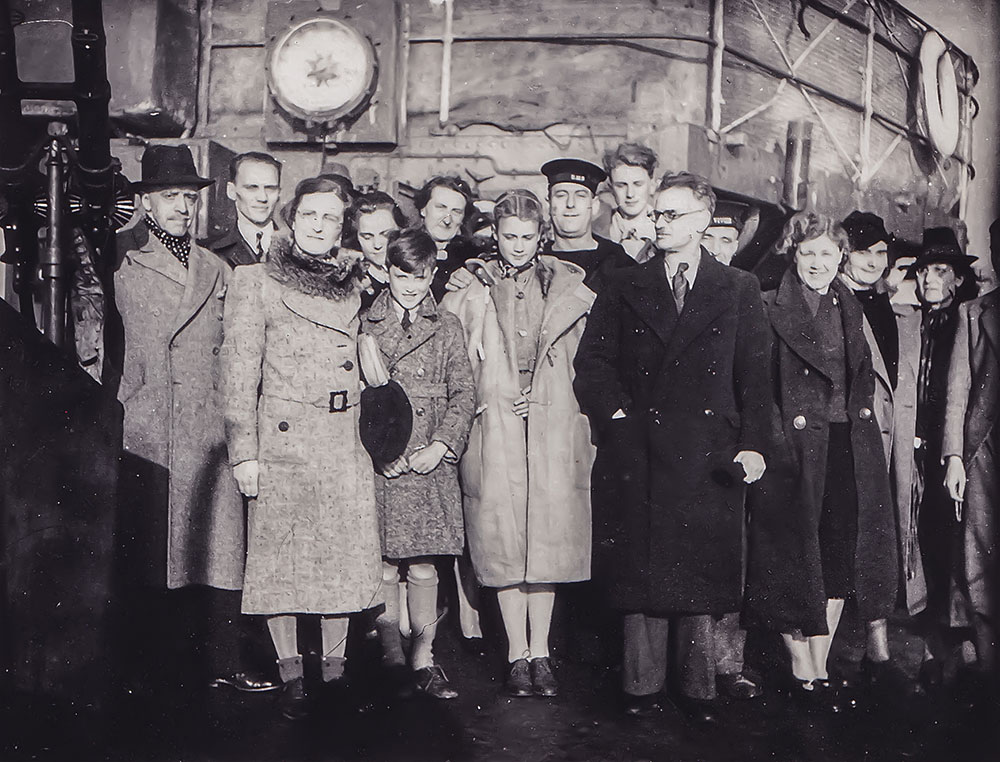
Dutch refugees on the port side of the upper deck aft, above the officers cabin flat where the ladies were to be accommodated
If you can can identify anybody in this photograph please get in touch now
Photographed by Sub Lt Herbert Walkinshaw RNVR and reproduced courtesy of Graham Cherry
The
officers cabins and wardroom reserved for the ladies are beneath the
deck on which they are standing and the mount for the twin 4-inch HA
dual purpose guns are on the superstructure behind. The gentleman in a dark overcoat on the right is thought to be George van Tets van Goudriaan head of Queen Wilhelmina's private office. The flood lamp above their heads
and twin machine gun mount on the left are also in the photograph of
the crew of the whaler posing with the the items from the Heinkel bomber.
Vivian leaving the Hook at high speed, which is under air attack in the distance
Photographed by Sub Lt Herbert Walkinshaw RNVR and reproduced courtesy of Graham Cherry
Vivien was bombed by three Junker, slipped her wires and left the Hook in a hurry. HMS
Versatile was
bombed at 2140 and her engine room put out of action. She could neither
steer or steam and two officers and five ratings were
killed. She was towed away from the jetty by HMS
Malcolm and taken in tow by HMS
Janus outside the harbour.
Versatile arrived Sheerness at 1940/14 .
HMS
Vivien was ordered to
Ijmuiden but with the harbour entrance blocked and the port being
bombed she headed to Tilbury, the main passenger port for London 25
miles down river from Tower Bridge on the Essex shore where P & O
liners docked and the London Midland and Scottish Railway had its
terminal. HMS
Vivien, W
indsor and
Mohawk arrived early the next morning at Southend.
Within a week of Vivien's return from the Hook of Holland Midshipman Benson-Dare heard of the death of his older brother,
Lt Ronald W. 'Pat' Benson-Dare, RN,
a 23 year old pilot with Fleet Air Arm Squadron 700 flying a catapult
launched Supermarine Walrus flying boat from the cruiser, HMS
Devonshire. He was shot down 32 miles south west of Tromso, Norway, on 18 May by a Heinkel He 111
. The only survivor, David Corkhill, gives
a very vivid description of the fight in an online recording
at the IWM and Brian Benson-Dare contributed to a detailed account of
the death of his brother written by Jan Stuart for Issue 50 of
Jaberwok, the magazine of Friends of the Fleet Air Arm Museum.
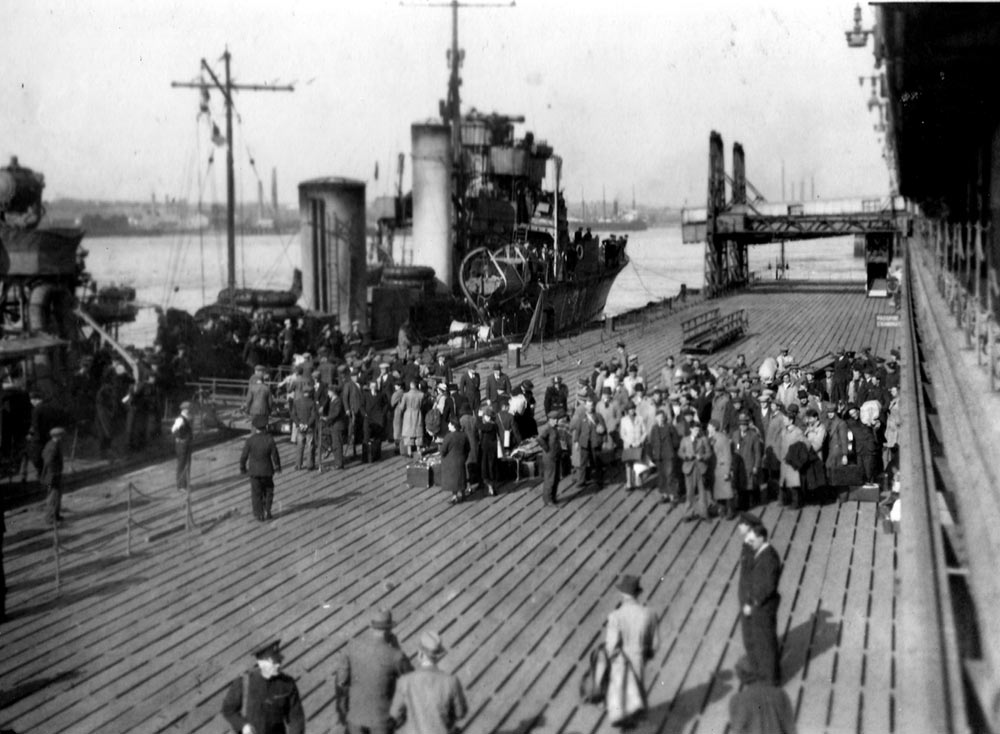
Refugees at Tilbury, uncertain what the future holds in store for them
Read about the restoring of Vivien's motor launch hanging on the starboard side
Photographed by Sub Lt Herbert Walkinshaw RNVR and reproduced courtesy of Graham Cherry
The Welsh and Irish Guards were evacuated from the Hook of Holland by twelve destroyers on the 14 May (Operation
Ordnance), led by Capt T.E. Halsey, Captain D16 in the Flotilla Leader HMS
Malcolm, the SNO at the Hook. Eight V & W Class destroyers took part: HMS
Whitshed, Verity, Wivern, Wolsey, Whitley, Winchester, Vesper and
Westminster.
A week later on 22 May the Guards were taken to Boulogne by
requisitioned cross channel ferries, escorted by V & Ws, to defend
the harbour city which was in danger falling to German forces advancing
east along the coast from Abbeville to encircle the BEF at Dunkirk. The
next day, under fire from German tanks, snipers and bombers they were
evacuated from the narrow harbour by the
Flotilla Leader HMS Keith and seven V & W destroyers in a dramatic prelude to Operation
Dynamo, the evacuation from Dunkirk.
While these events were taking place HMS
Vivien
was back on the - usually - humdrum job of escorting east coast
convoys. On 9 June Convoy FN.192 departed Southend, escorted by
Vivien.
When east of Lowestoft she reported attacks by German e-boats, the
first reported attack by e-boats on an east coast convoy. The SS
Baron Elphinstone (4635 grt) at the rear of the convoy was attacked near Smith's Knoll. The destroyers HMS
Jackal and
Foresight
were ordered to close the convoy for the night and remain with it until
daylight and two Anson and two Hudson arcraft shadowed the convoy and
attacked the German vessels northeast of Schouwen Bank off the Dutch
coast at 0355/10. The convoy arrived at the Tyne on the
11th. The
Gazette
of 5 July announced that Lt Cdr Weir was Mentioned in Despatches (MID)
and AB Horace Leslie Osborne was awarded the DSM "for skillful services
in helping to save a Convoy when attacked by enemy motor torpedo boats
at night". The narrow channels off the coast of Norfolk and
Suffolk became known as "e-boat alley" due to the fequency of these
attacks.
On 6 July Lt Cdr Weir was succeeded as CO of HMS
Vivien
by Lt Cdr S.H. Beattie. Weir had ben CO since 19 September 1939 and his
officers had known no other. Three days later he was awarded the OBE in
the 1940 Kings Birthday Honours List, postponed from 13 June due to the
change of cabinet when Winston Churchill took over as PM in May. All
the awards were in recognition of war service and it is reasonable to
asume that he received the OBE for the evacuation of civilians from the
Hook of Holland. He commanded the MTB base HMS
Hornet and was made CO of HMS
Windsor
in early 1941 but his health had not been good for some years and he
was placed on the Retired List on account of age with the rank of
Commander on 23 May, 1942. He continued in service at shore bases in
the tropics including HMS
Malabar, Bermuda, in 1943 and left the service in 1947.
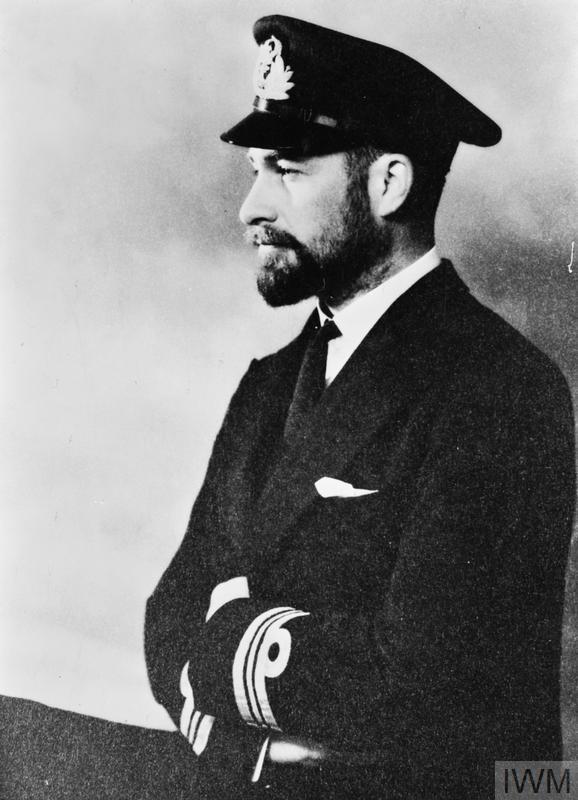 Lt Cdr Beattie, a future winner of the Victoria Cross
Lt Cdr Beattie, a future winner of the Victoria Cross
The new CO,
Stephen Haldane 'Sam' Beattie, was born in 1908 at the
Vicarage in Leighton, Wales, where his father was a Presbyteriam
Minister. He was educated at Rugby and joined the Navy as a direct
entry in 1925. He had served as a Midshipman and Sub Lieutenant in the battleships HMS
Barham and HMS
Warspite in the 1920ies, as a lieutenant in the V & Ws HMS
Windsor and HMS
Vesper (in reserve) and as First Lt of the destroyers HMS
Arrow and HMS
Zulu before being given command of HMS
Vivien as Lt Cdr S.H. Beattie RN. Glory and the award of the VC for his part in the raid on St Nazaire lay ahead.
The convoys along the east coast were protected by the east coast
minefield from German e-boats and the dual purpose high attitude 4-inch
Guns of the WAIR converted V & W escorts provided a defence against
e-boats and bombers but mines parachuted by German aircraft parachuted
into the narrow navigable channels presented a new hazard after the
fall of France.
On the 13 August HMS
Vivien and the sloop
Fleetwood left the Tyne with Convoy FS.251 for Southend and on 15 August the 1,557 collier SS
Brixton
detonated a mine off the Suffolk coast near Orford
Ness. Herbert Walkinshaw
photographed
Vivien
lowering her whaler to rescue her crew. The collier was sunk but nobody
was killed and the convoy arrived at Southend later that day.
Lt Cdr Beattie described the mining and the rescue in his report (ADM 199/220/77).

Vivien lowers her whaler - or motor dinghy?- to rescue survivors from the collier SS Brixton - also see below
The 16 ft motor dinghy is being lowered from it davits on the starboard side
Photographed by Sub Lt Herbert Walkinshaw RNVR and reproduced courtesy of Graham Cherry
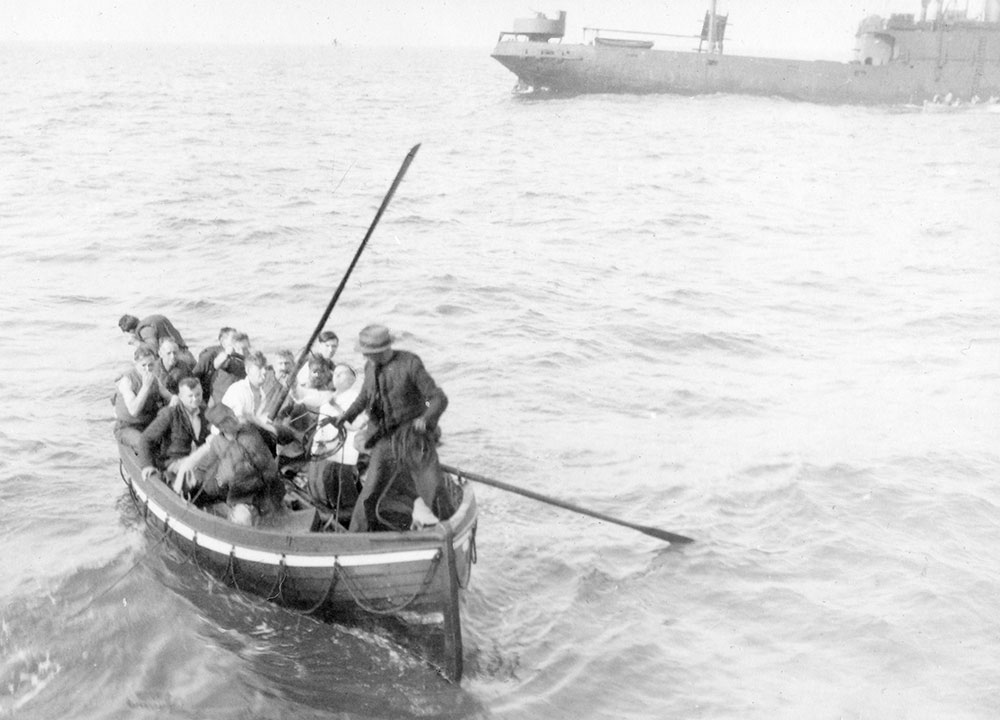
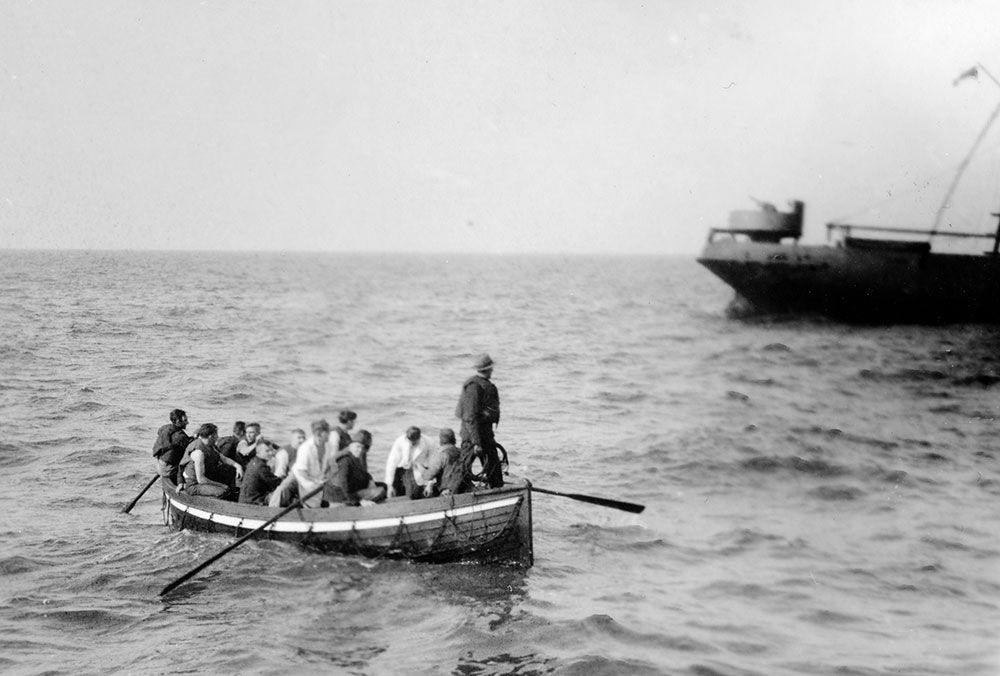
There are thirteen men in this photograph of the rescue of survivors from the coaster SS Brixton
Could they fit in the 16 foot motor dinghy slung on the starboard side of HMS Vivien or was the 27 ft whaler on the port side used?
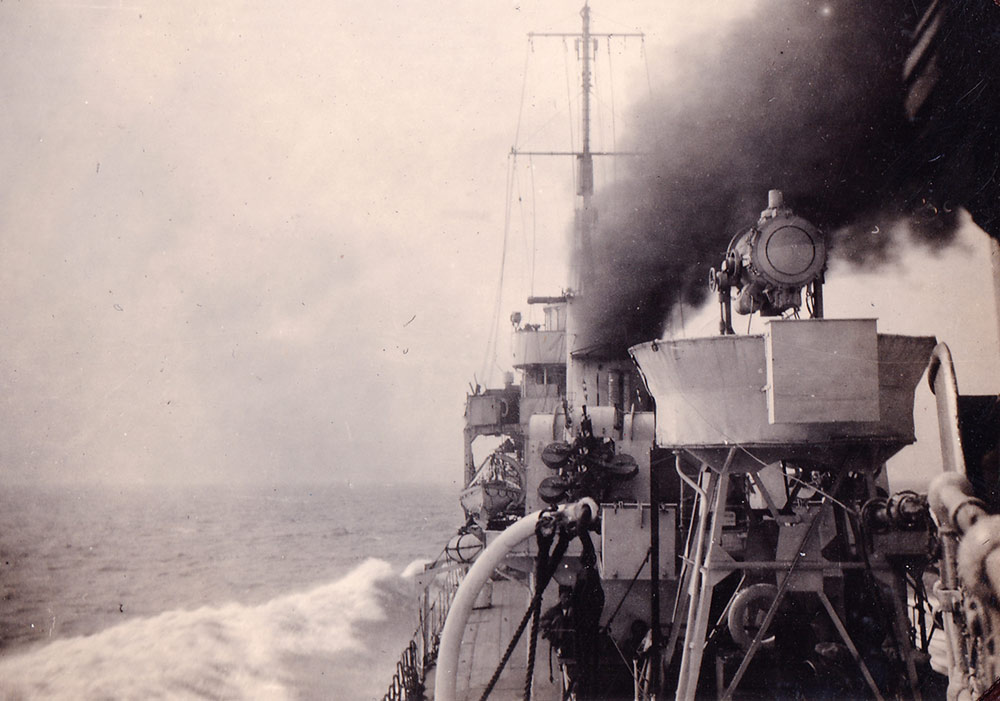 "Full power trials in July 1940"
"Full power trials in July 1940"
The searchlight platform is in the foreground and a quad mtg with four magazines for a machine gun between it and the whaler
Officers and Gentlemen
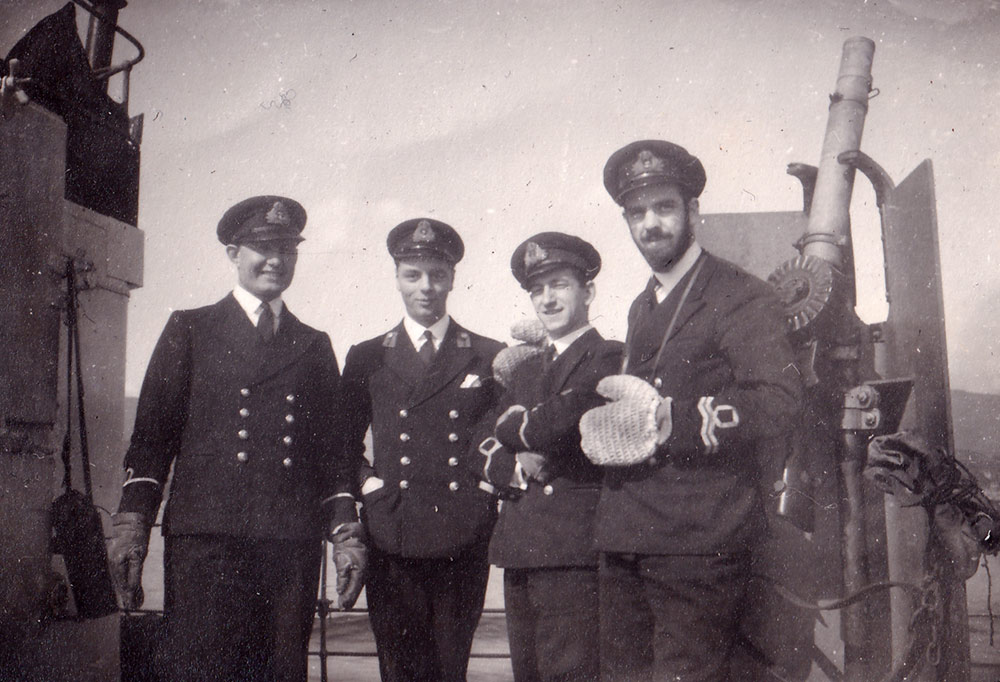
The caption "Guns, Hoskins, Self, Doc" identifies them as
Gnr
G.H. Simmons, Mid Hoskins, Waliknshaw (self) Surg Lt R. O’Kane RNVR
(whose beard resembled that of his CO, Lt Cdr S.H. Beattie)
It looks as if they have donned thick heavy gloves to protect their uniforms from the oil on the 0.5 inch Browning machine gun
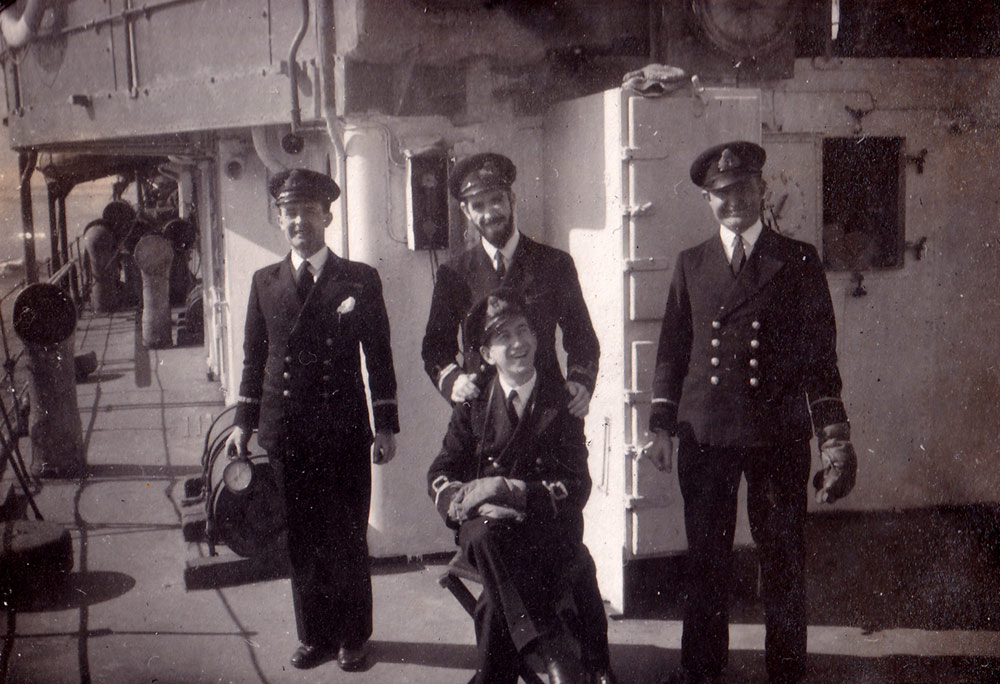 The caption in the album: "Clyde, April 1940: Chief, Doc , Guns, Self" (front)
The caption in the album: "Clyde, April 1940: Chief, Doc , Guns, Self" (front)
From left: Cd Eng Teush, Surg Lt Kane, Gnr Simmons and Walkinshaw (front)
Wearing the same gloves so taken at the same time and just fooling around
Ratings and shipmates
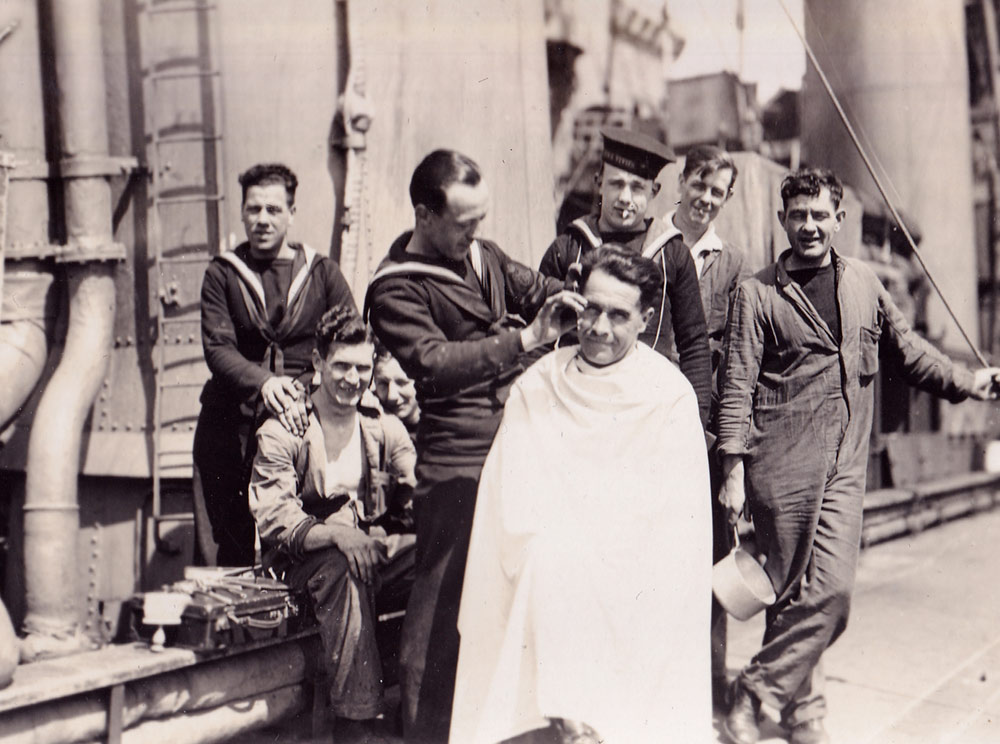 Waiting their turn for the Barber's Chair
Waiting their turn for the Barber's Chair
"Standing: Kelly, Davie, Thurlow, Firlie, Stoker Sitting: Donald, Hickmott, Cabbey"
The HO rating cutting their hair may have been a barber before the war
Several
hundred convoys were escorted along the east coast duing the war and
the numbers assigned to FN and FS convoys became unwieldy and they were
given an additional numeric prefix to distinguish between years but
discrepancies arise between the numbers assigned by commanding officers
to their reports in the National Archives and the numbers used on
websites and in books.
On 16 October HMS
Vivien was
attacked by German e-boats while escorting a north bound convoy
referred to as Convoy F9 but the RoP of the senior officer of the
convoy is in doubt and can not at present be given with certainty.
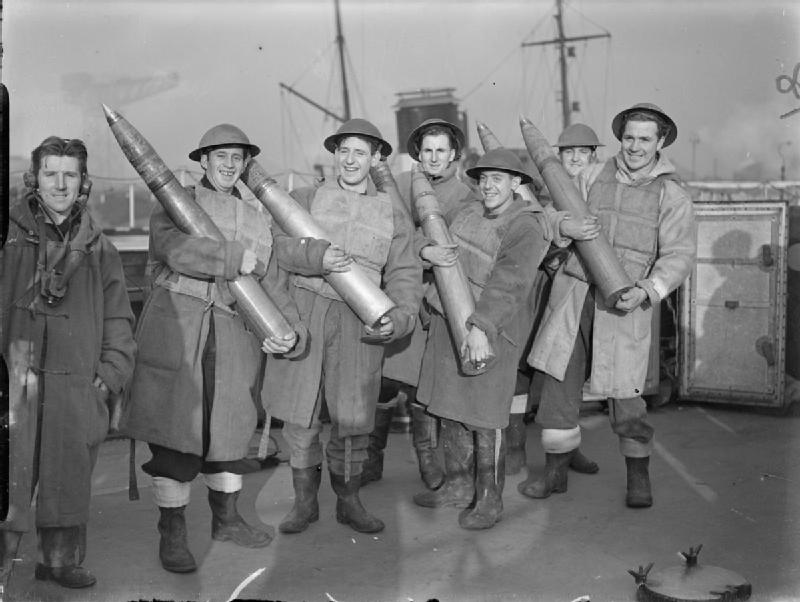 The gun crew display shells for the QF 4 inch Mk XVI guns used to shoot down an enemy aircraft and severely damage another
The gun crew display shells for the QF 4 inch Mk XVI guns used to shoot down an enemy aircraft and severely damage another
Photographed by Lt S.J. Beadell, RN Official Photographer (IWM Ref A1770)
November 1940
11 November
Convoy FN.332 departed Southend, escorted by destroyer VIVIEN and sloop LONDONDERRY. The convoy arrived at Methil on the 14th.
Convoy FS.333 departed Methil, escorted by destroyers EGLINTON and WATCHMAN. The convoy arrived off Southend on the 13th.
German bombers attacked convoys FN.332 and FS.333.
Norwegian steamer RAVNANGER (3371grt) was sunk by German bombing one to
one and half miles northeast of No. 20 Buoy, Middlesborough, in Tees
Bay.
One crewman was lost on the Norwegian steamer.
British steamers CORSEA (2764grt), CORDUFF (2345grt), and COLONEL
CROMPTON (1495grt) in a convoy were damaged by German bombing in Barrow
Deep off Middlesborough.
Escorting escort vessel VIVIEN (Lt Cdr F. H. Beattie) shot down one
Junkers bomber, sloop LONDONDERRY (Cdr J. S. Dalison) shot down another
Junkers bomber, tug ST MELLONS (T/Lt H. L. Forster DSC RNR) shot down a
Messerschmidt.
Reports of Proceedings at NA:
https://discovery.nationalarchives.gov.uk/details/r/C17166451
ADM 199/39/27
Convoy: FS 30 and FS 31.
Report of Proceedings for convoy FS 30 by Commanding Officer, HMS Lowestoft. Includes details of sinking of
SS Baltrader. 1940 Nov 11.
The cargo ship (1,699 GRT, 1919) struck a mine and sank in the North Sea (51°41′N 1°18′E) with the loss of two crew.[8][52]
THAMES ESTUARY OFF CLACTON - MINED
Report of Proceedings for convoy FS 31 by Commanding Officer, HMS Londonderry. 1940 Nov 13.
Report by Commanding Officer, HMS Vivien, on damage to enemy aircraft while escorting convoy FS 31.
1940 Nov 12.
By March 1941 HMS Vivien had transferred to Western Approaches Command amd was based at Liverpool or Geenock on the Clyde.
The "Good Shepherd" with one of her charges
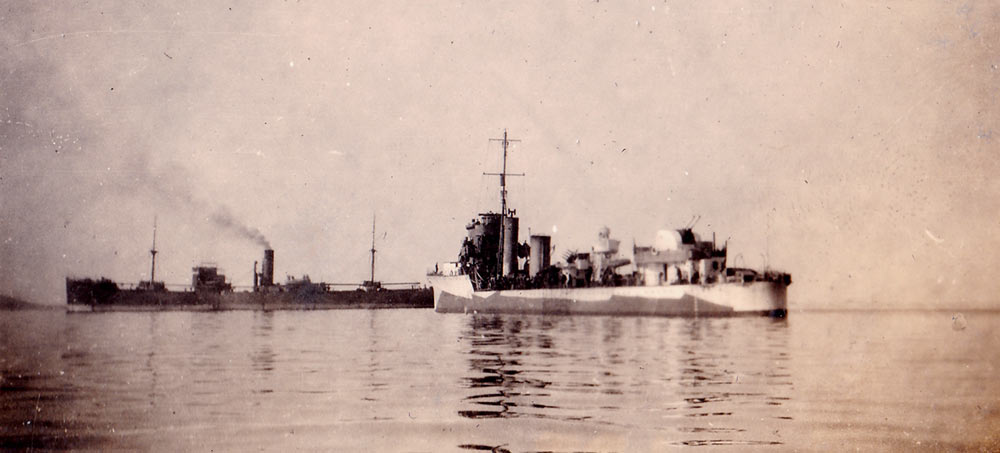
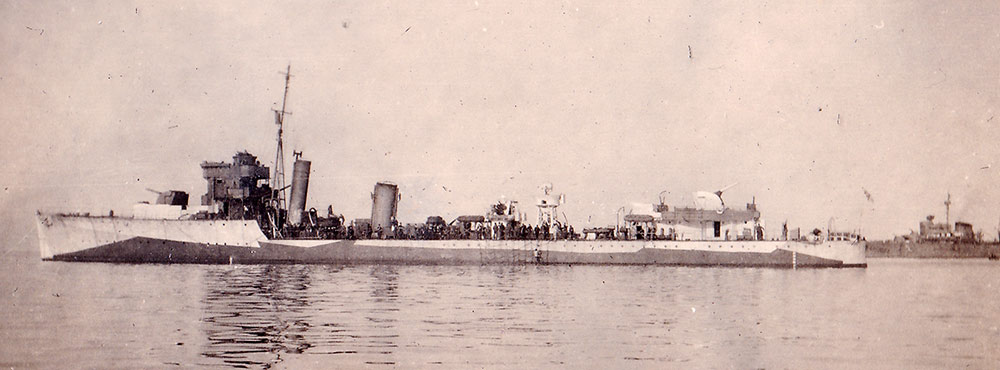
Seamen crowd the rail as a survivor climbs a scrambling net to safety aboard a convoy escort
The camouflage scheme suggests these photograph of a WAIR converted V & W were taken in 1941 when Vivien was based at Greenock
There are no Pennant Numbers visible but if they are of HMS Vivien they could not have been taken by Sub Lt Walkenshaw
The "Good Shepherd" has not been identified but is unlikely to be HMS
Vivien if Sub Lt Walkinshaw took the photographs. She is painted in the distinctive Western Approaches camouflage developed by
Lt Peter M. Scott RNVR, while First Lt of V & W Class Leader, HMS
Broke.
Scott, the son of "Scott of the Antarctic", became famous after the war
as author and television presenter of programmes on natural history and
founder of the Slimbridge Wetland Wildlife reserve. By May 1941, all
ships in the Western Approaches were ordered to be painted in Scott's
camouflage scheme and these two photographs of a WAIR converted V &
W were probably taken after HMS
Vivien was moved to Western Approaches Command at Greenock on the Clyde. The
WA Camouflage Scheme is described and illustrated with drawings by Alan Raven snd John Roberts in their little known booklet
V & W Destroyers, published in Britain by Arms and Armour Press in 1979.
Members of the "Atlantic Club" sailing the ship's whaler
click on the images to view full size in separate windows

The caption: "Guns, Main, Doc, Chief, Hoskins"with "Self" - sprawled in front
Gunner G.H. Simmons, Sub Lt J.W. Main, Surg Lt R. O’Kane
RNVR, Cd Eng F.D.E. Teush, Mid R.O Hosking RNR and Sub Lt H. Walkinshaw
as "Self"
|
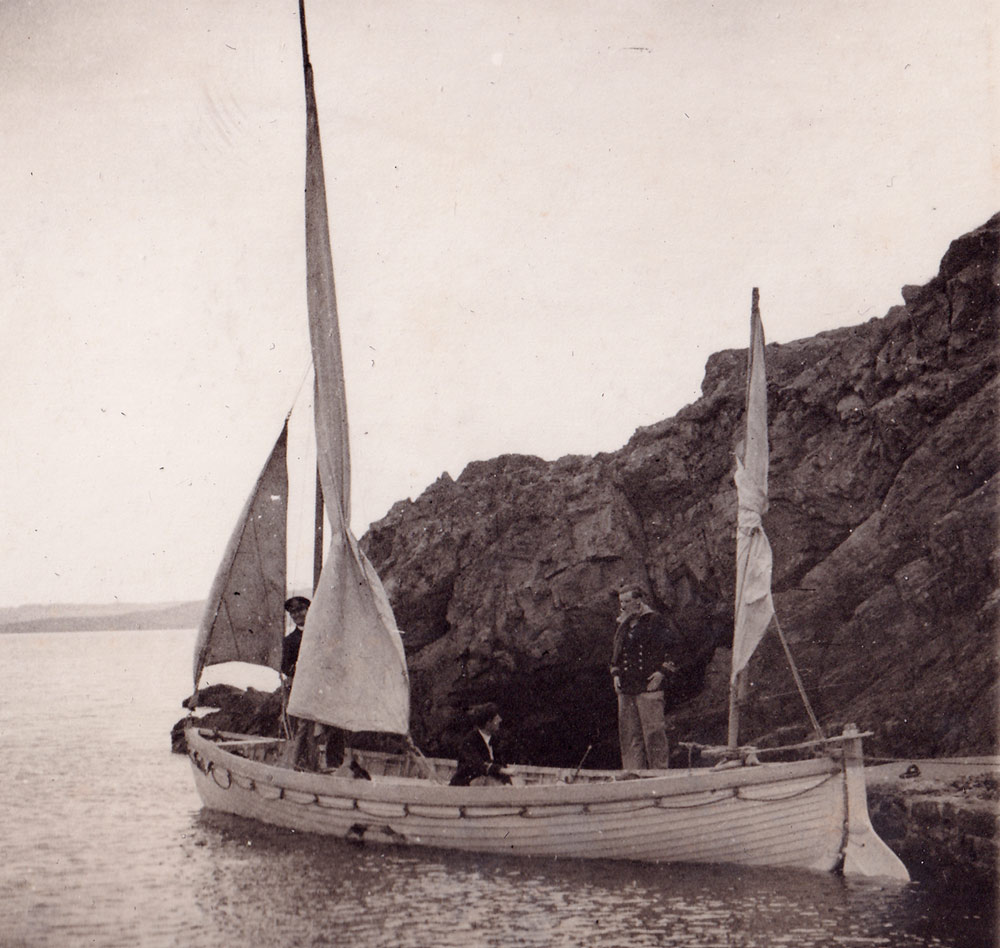
The caption: "Vivien's whaler - Guns, self Main"
Gunner G.H. Simmons, Walkinshaw and Sub Lt Main
|
From Windjammers to Battleships!
Because of its position in Herbert Walkinshaw's photograph album immediately after the photographs of HMS
Pelican I assumed this photograph of
the famous Windjammer Padua
built at Bremerhaven in 1925 was taken in 1940 while she was being
towed by a tug to Britain after being seized in a Norwegian port but I
found no evidence that she had ever been in Norway and on digging a
little deeper found she had featured in two popular wartime German
films including
Grosse Freiheit Nr. 7
(Great Freedom Street No. 7) set in Hamburg with its port
pubs and restaurants which ran foul of German censors but is
still highly regarded today. I was reluctantly forced to the conclusion
that it was photographed after the war when she was the Russian Sail
Training Ship
Kruzenshtern.
I thought the Padua was the only surviving member of the Flying-P Line still afloat but I was wrong. The Peking
was built at Hamburg in 1911 and was for forty years a museum ship in
New York but in 2017 returned to Hamburg on a heavy lift ship and
underwent a three-year restoration at Peters Werft shipyard in
Wewelsfleth, Germany. In September 2020 the Peking
was towed back to Hamburg, greeted by a flotilla of supporters and
throngs of wellwishers along the riverbanks. The ship will be the
centerpiece of a new German Port Museum, part of Historic Museums
Hamburg, scheduled to be completed by 2025. Read more about her on "The Old Salt Blog".

 HMS VIVIEN
HMS VIVIEN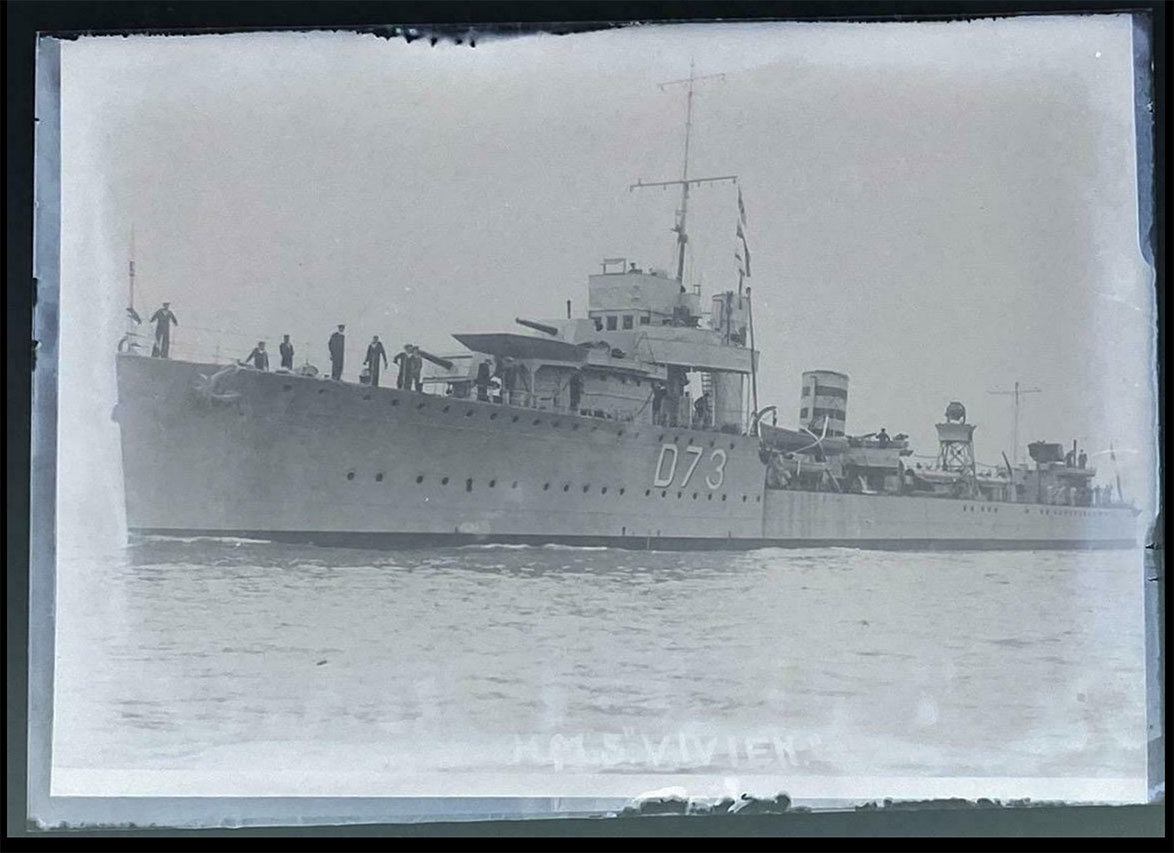
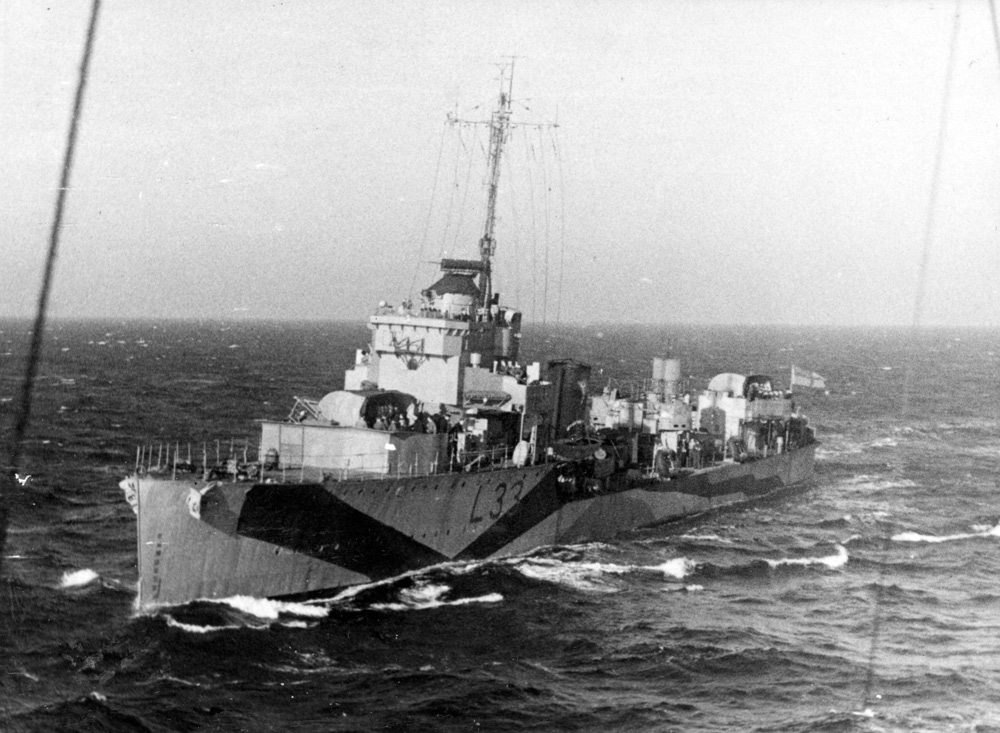
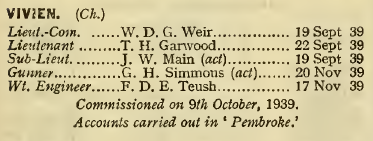 Despite
these problems it was possible to identify the full name and rank of
all the officers by linking them to entries in the Navy List for officers serving in HMS Vivien in 1939 to 1941. Midshipman Brian James Benson-Dare RNR was indexed as being in Vivien but is missing from the Navy List for February 1940 on the left. He was wrongly recorded as serving in HMS Windsor.
He and his elder brother were sent to The Nautical College Pangbourne
to train as officers in the Merchant Navy but the war changed that. He
joined HMS Vivien on 22 September, the same day as First Lt T.H. Garwood. The original owner of the Album was Sub Lt Herbert Aubrey Walkinshaw RNVR who joined HMS Vivien
on 9 October 1939, the day she commissioned, and left in August
1941. He was also omitted from the NL on the left but appeared in the Navy List for June 1940.
Despite
these problems it was possible to identify the full name and rank of
all the officers by linking them to entries in the Navy List for officers serving in HMS Vivien in 1939 to 1941. Midshipman Brian James Benson-Dare RNR was indexed as being in Vivien but is missing from the Navy List for February 1940 on the left. He was wrongly recorded as serving in HMS Windsor.
He and his elder brother were sent to The Nautical College Pangbourne
to train as officers in the Merchant Navy but the war changed that. He
joined HMS Vivien on 22 September, the same day as First Lt T.H. Garwood. The original owner of the Album was Sub Lt Herbert Aubrey Walkinshaw RNVR who joined HMS Vivien
on 9 October 1939, the day she commissioned, and left in August
1941. He was also omitted from the NL on the left but appeared in the Navy List for June 1940. 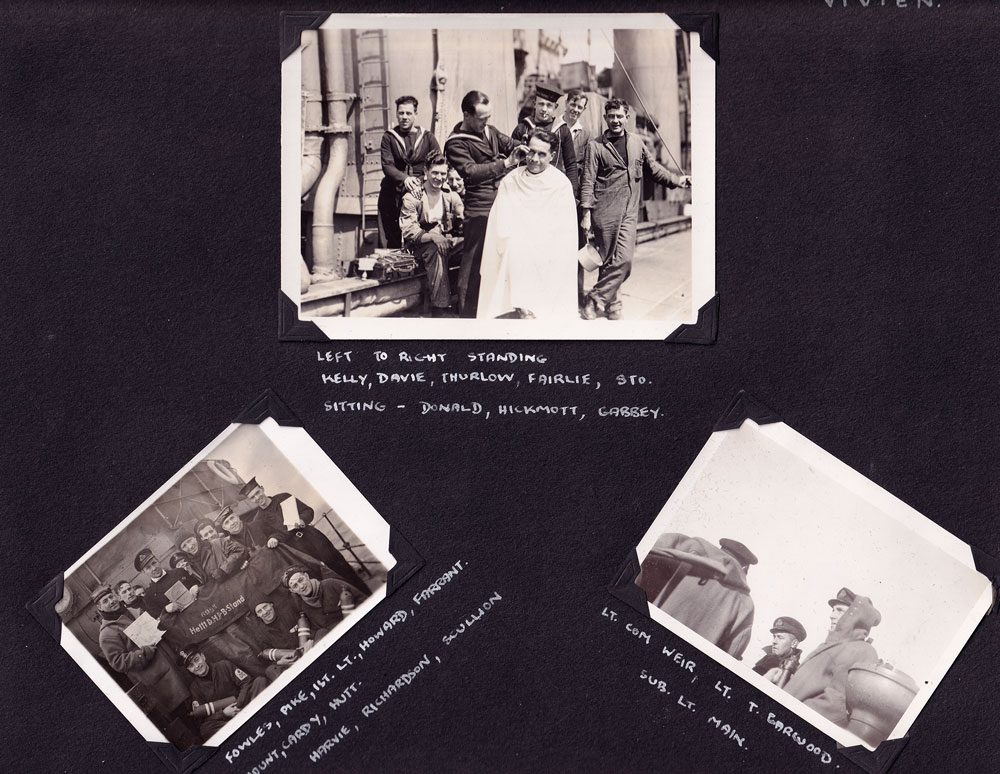
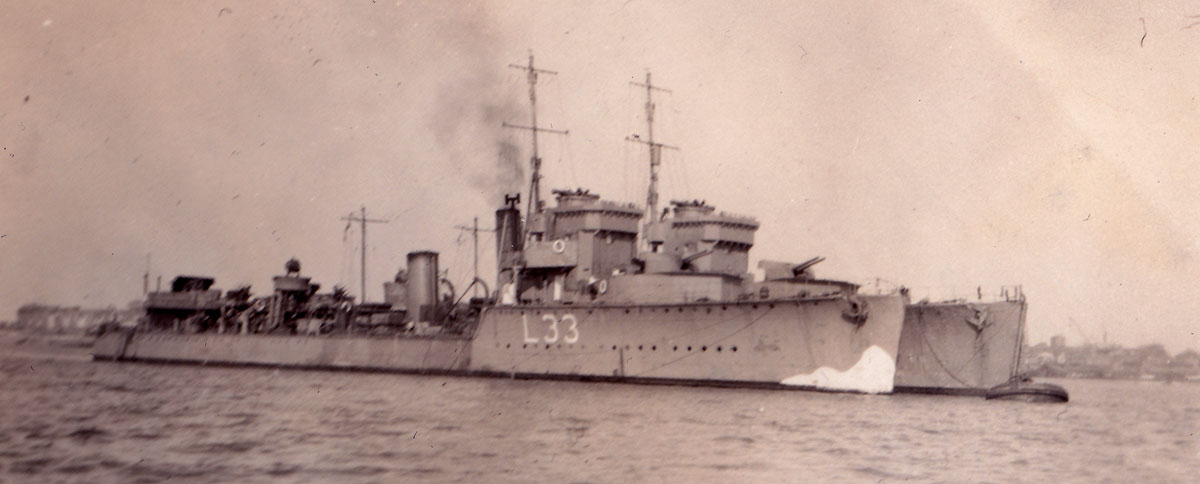
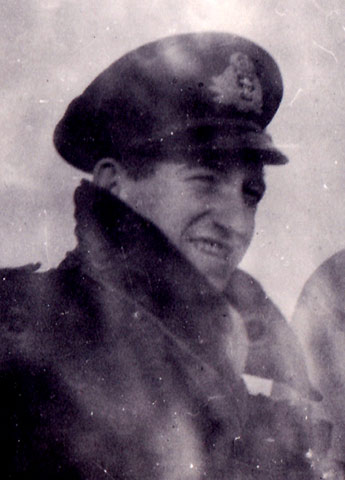
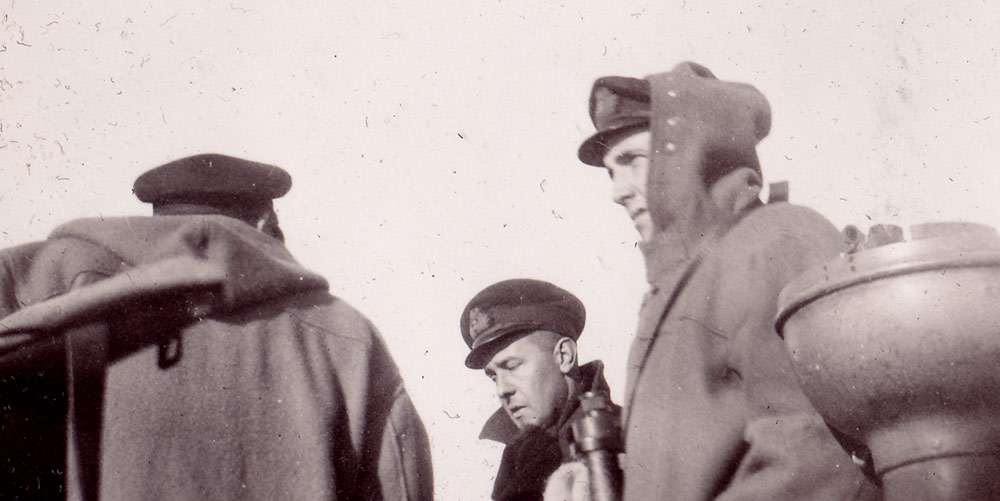
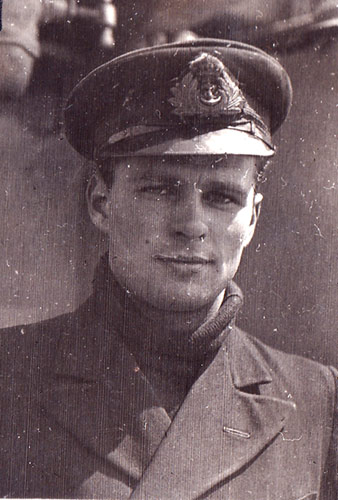
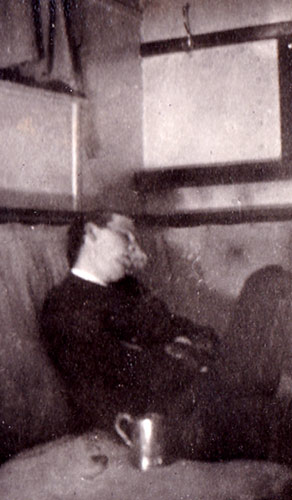
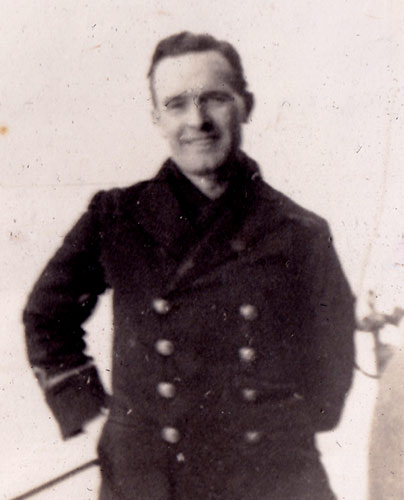
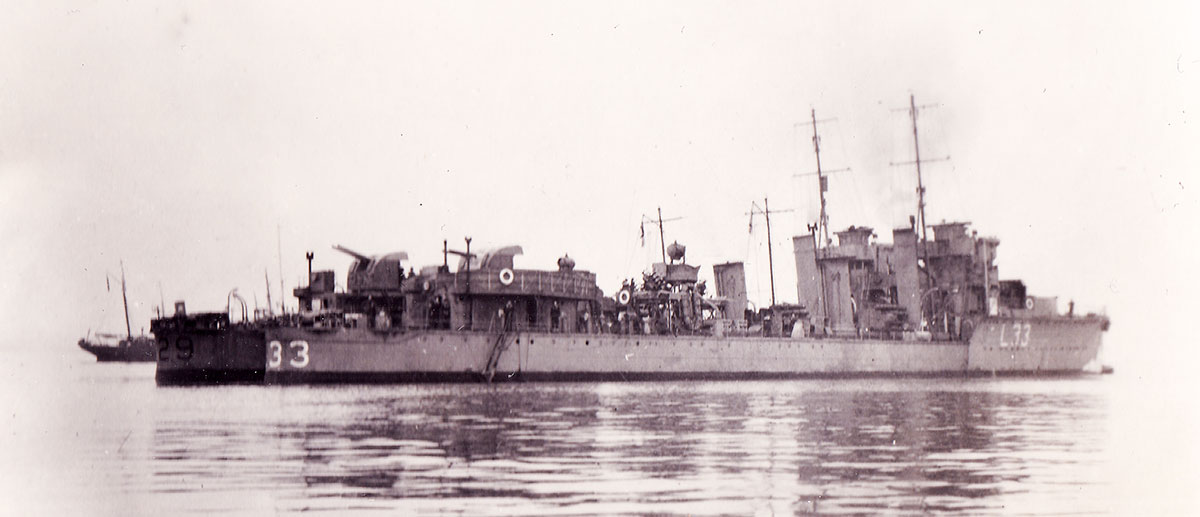

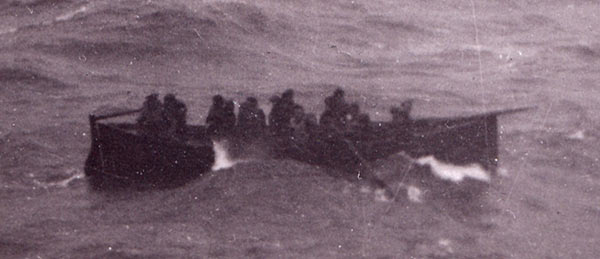 The burning oil tanker and the rescue of the crew by the whaler from HMS Vivien were photographed by Sub Lt Walkinshaw and described by Lt Cdr Weir in his Report of Proceedings at the National Archives
(TNA) at Kew. The NA is closed due to the pandemic but further details
will be given here when a copy of his report is obtained when the
National Archives reopens.
The burning oil tanker and the rescue of the crew by the whaler from HMS Vivien were photographed by Sub Lt Walkinshaw and described by Lt Cdr Weir in his Report of Proceedings at the National Archives
(TNA) at Kew. The NA is closed due to the pandemic but further details
will be given here when a copy of his report is obtained when the
National Archives reopens. 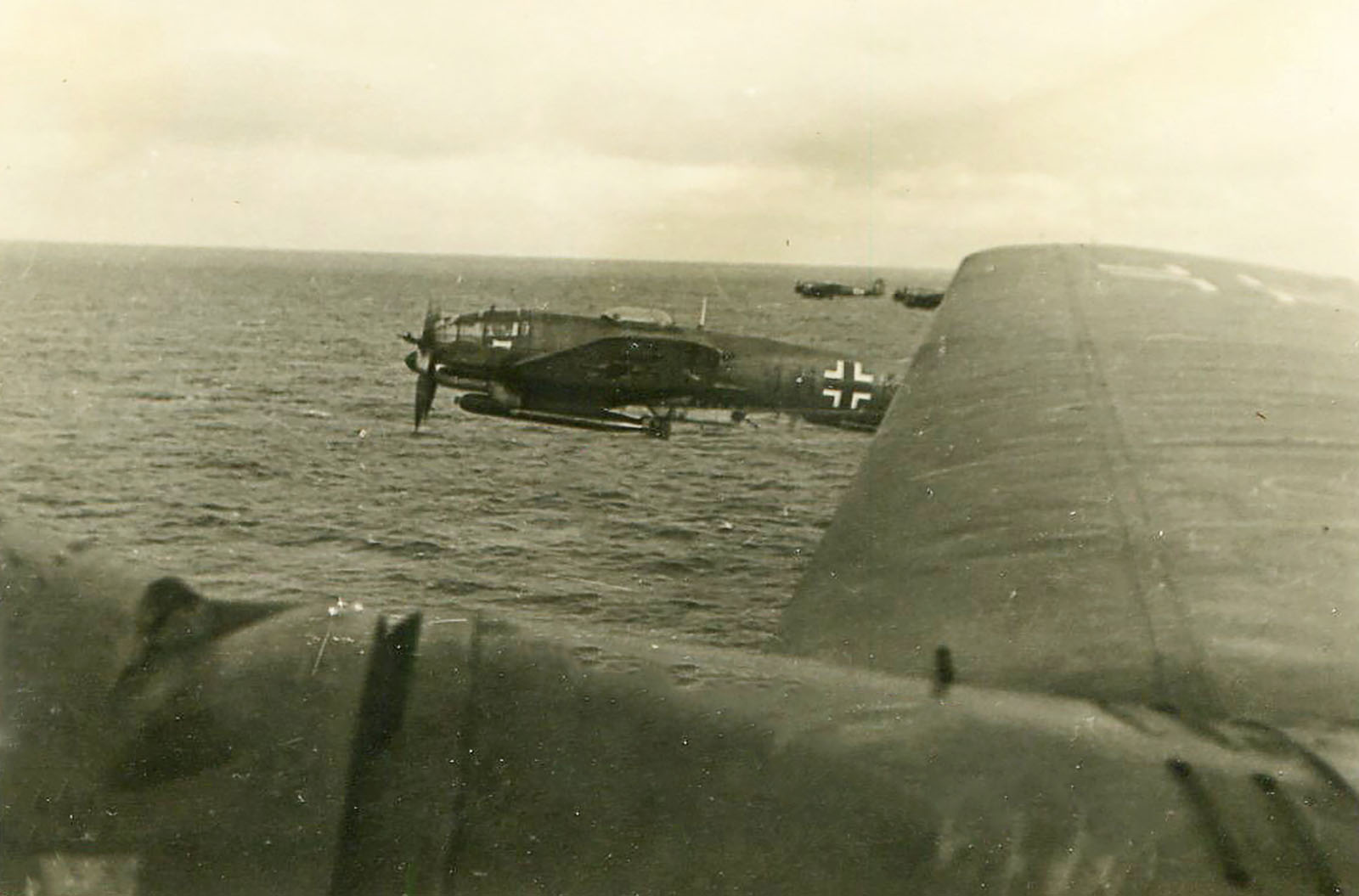
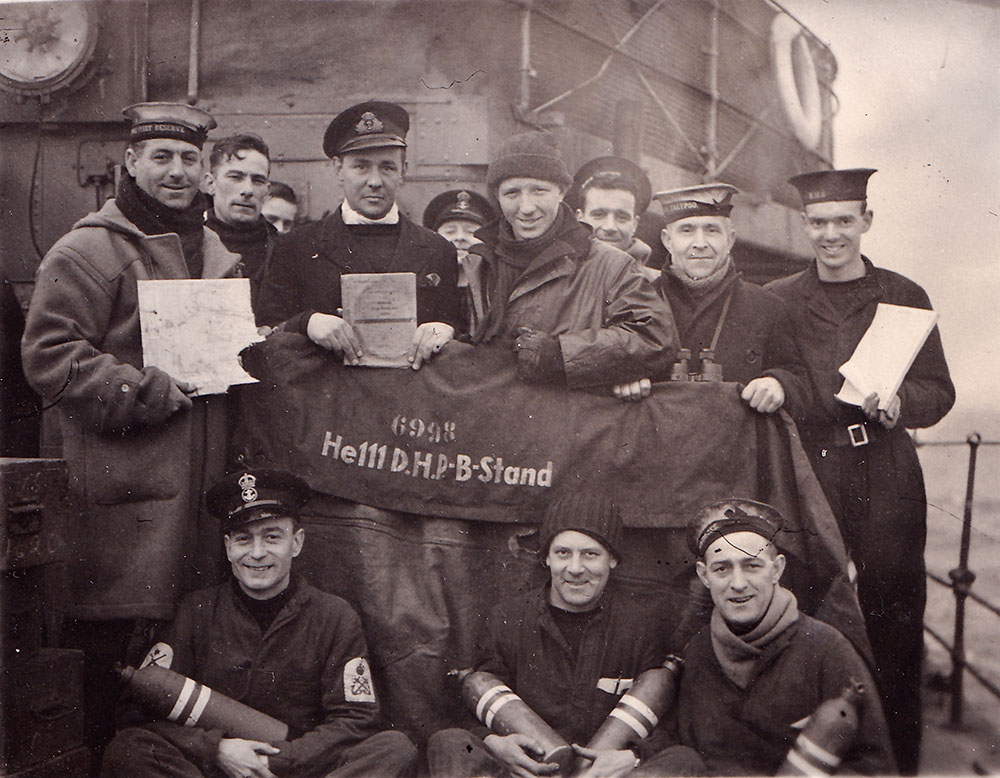
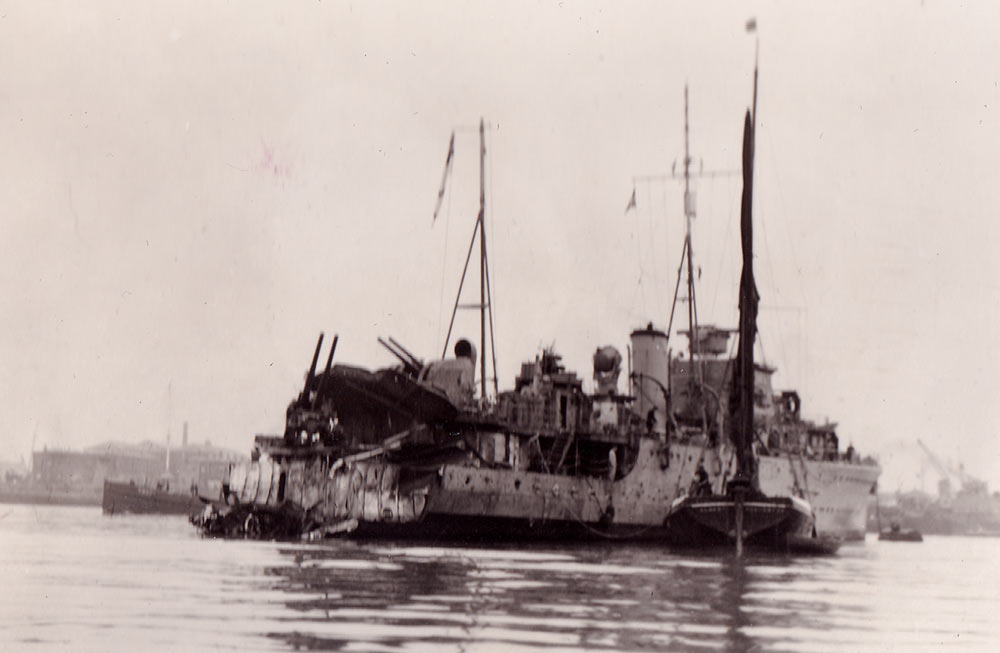
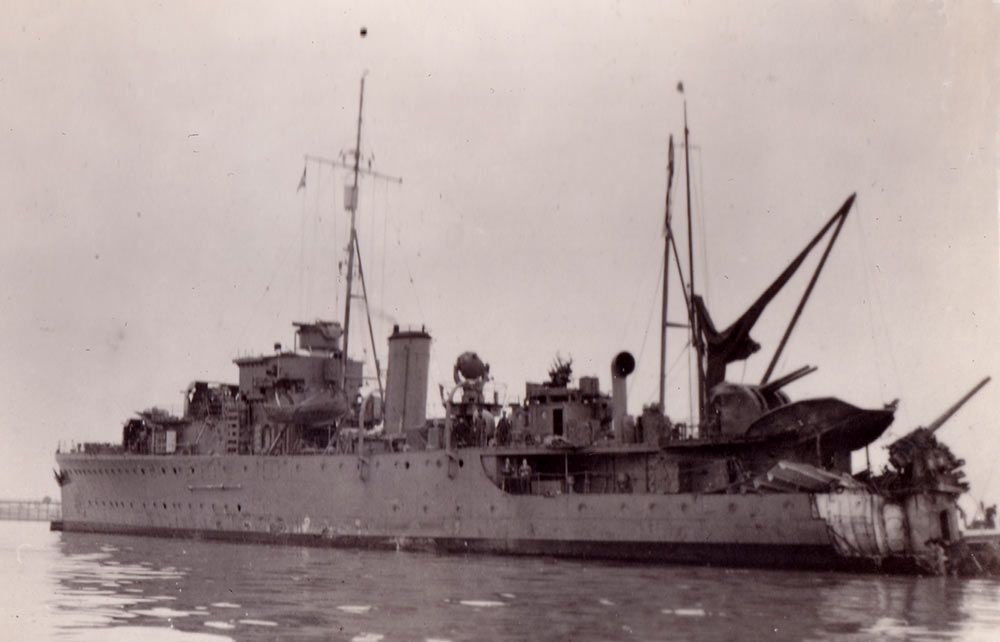
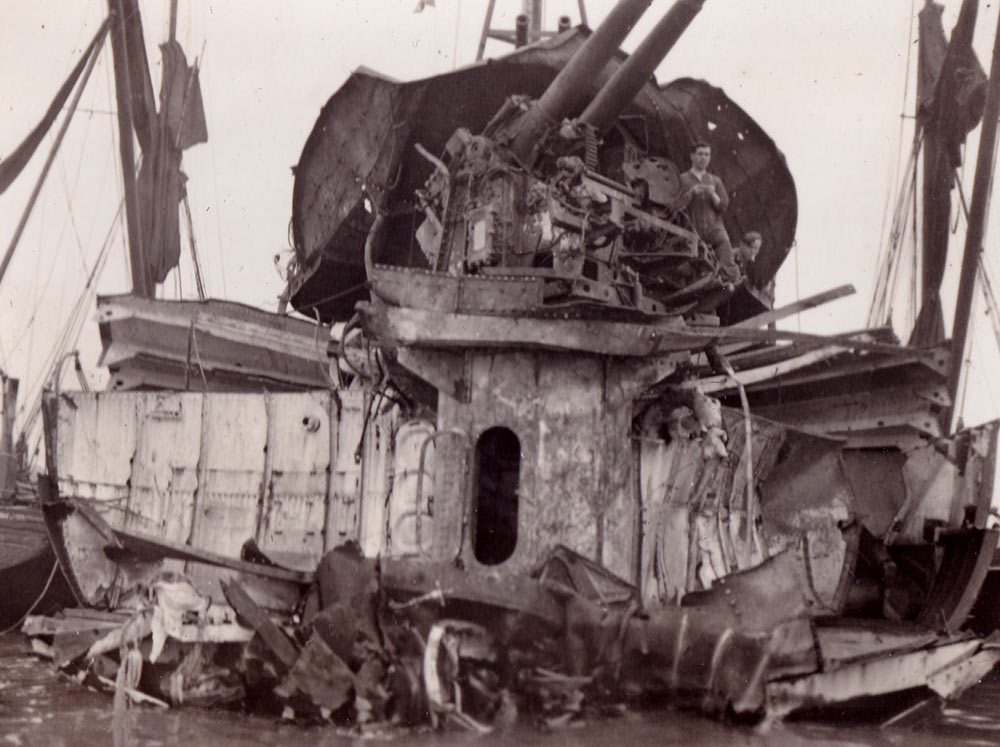



 HMS Vivien and HMS Windsor
were two of the destroyers which carried out the evacuation from the
Hook of Holland on the evening of Whit Monday 13 May. We have an
eye witness account by Midshipman Brian James Benson-Dare who was on
the bridge of HMS Vivien during the evacuation.
HMS Vivien and HMS Windsor
were two of the destroyers which carried out the evacuation from the
Hook of Holland on the evening of Whit Monday 13 May. We have an
eye witness account by Midshipman Brian James Benson-Dare who was on
the bridge of HMS Vivien during the evacuation. 


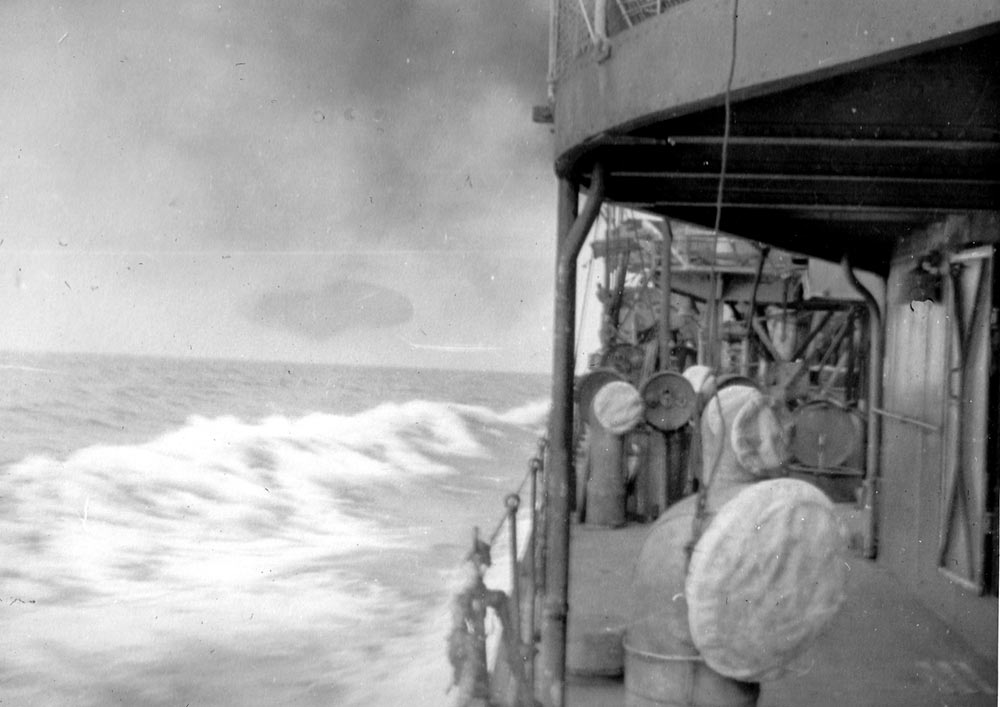
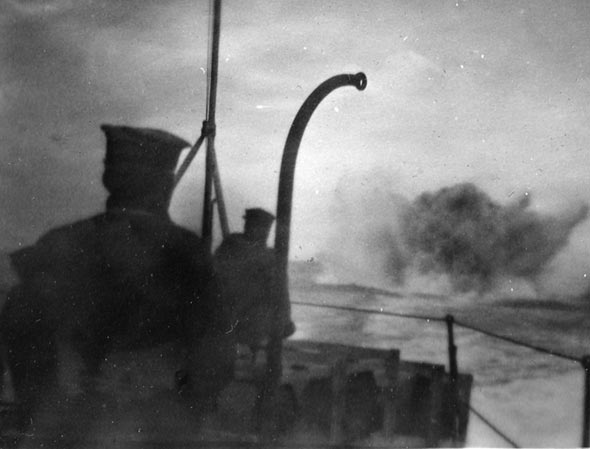

 Lt Cdr Beattie, a future winner of the Victoria Cross
Lt Cdr Beattie, a future winner of the Victoria Cross








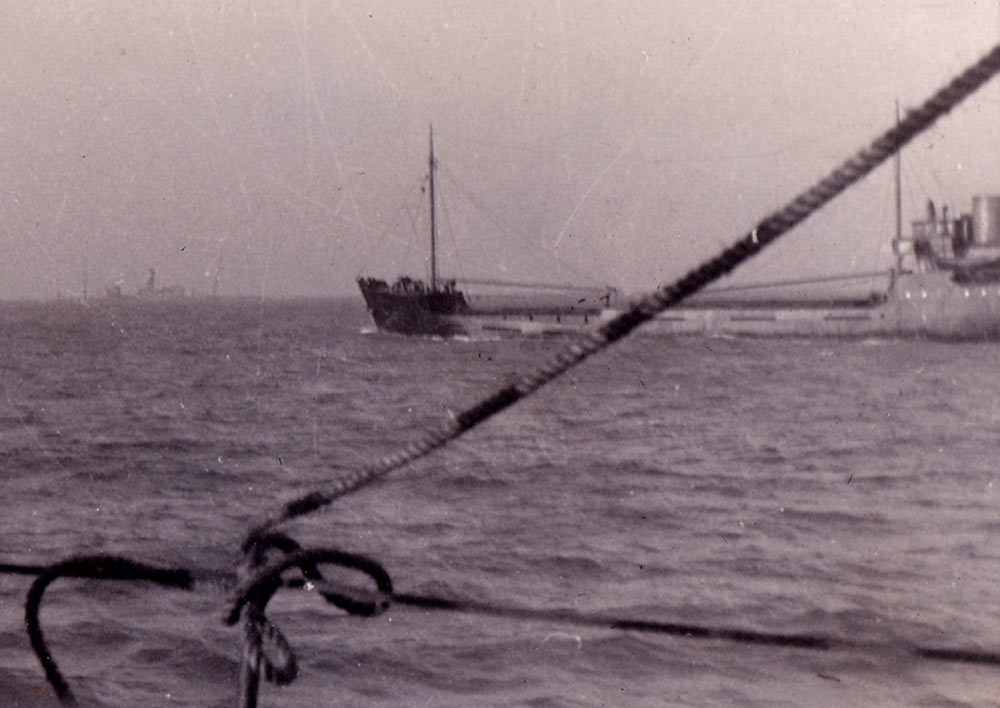
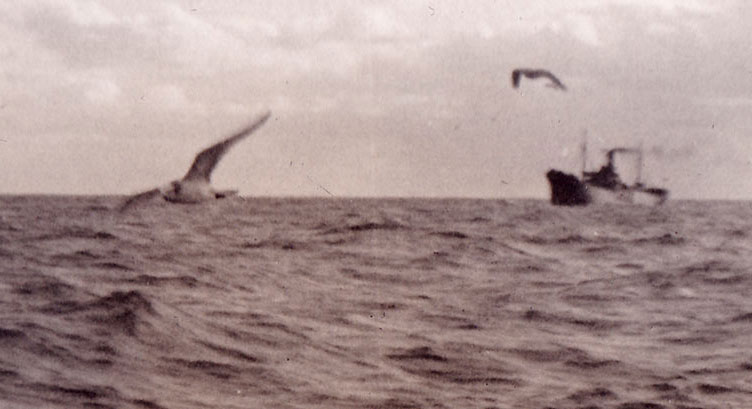

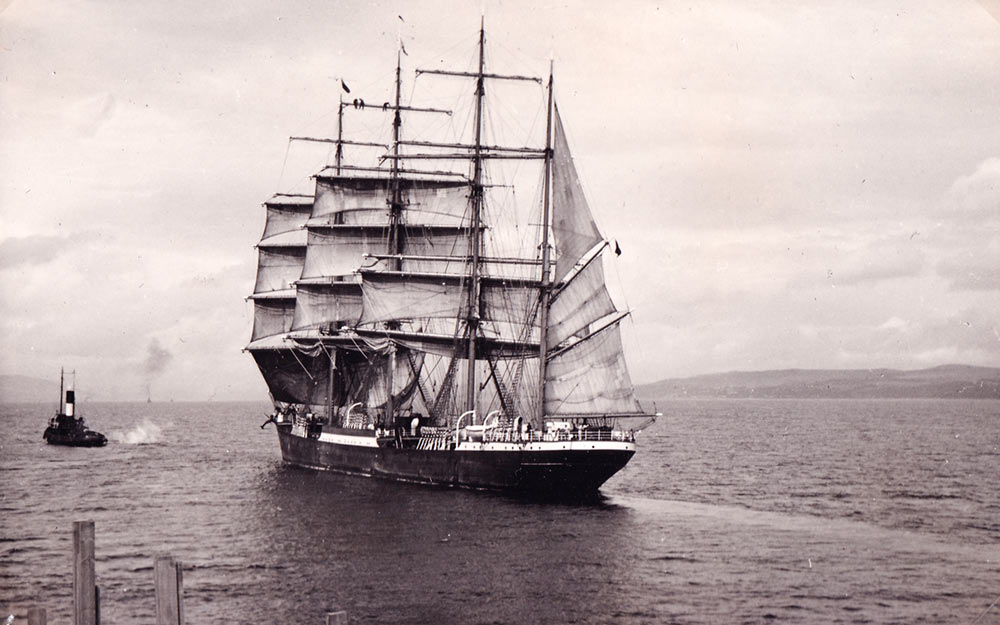
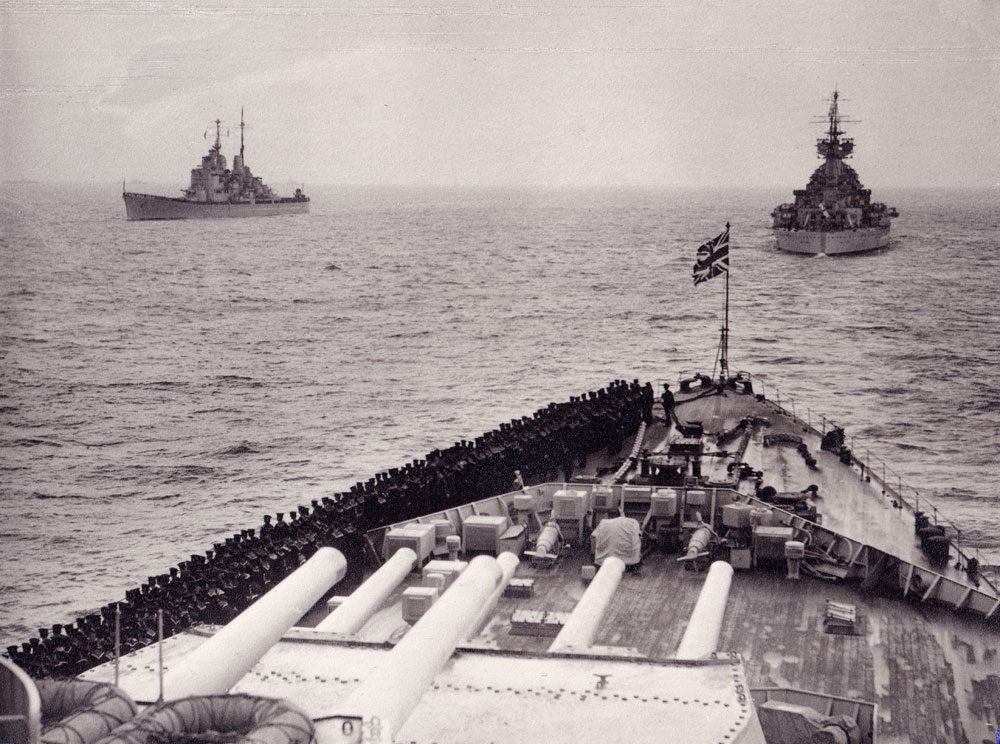
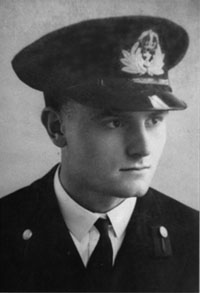
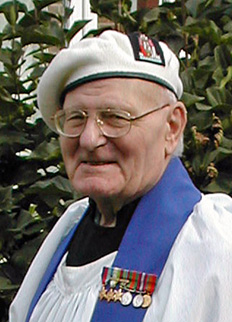 Shipmate John S. Appleby,
the Honorary Secretary of the V & W Association until his death,
died on the 30 August 2011 aged 86. He was born at Colchester on the 29
March 1925 and lived there all
his life with the exception of his wartime service in the Royal Navy.
Shipmate John S. Appleby,
the Honorary Secretary of the V & W Association until his death,
died on the 30 August 2011 aged 86. He was born at Colchester on the 29
March 1925 and lived there all
his life with the exception of his wartime service in the Royal Navy.